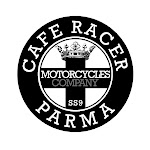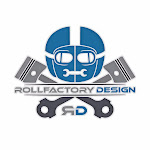The awesone Triumph Bonneville 900 by DMOL - Death Machines of London
Starting from the frame, it has been finished in a deep coat of Beluga Black, it's been
de-lugged, weld cleaned and extensively modified with an entirely new
rear. Engine work comprised of a gas flowed cylinder head and remapped
fuelling to suit the custom exhaust system. The fuel pump and injection
system have been remodelled and uprated with the oil cooler being
removed as a weight reduction measure. The custom velocity stacks,
designed to assist the remapped fuelling programme, feature a brushed
outer and mirror polished interior surface with etched brass grills and
DMOL logo inlays. The sprocket is protected by a custom cage, which also
features solid brass grills and an engraved name plate. Custom designed
and copper coated injection caps together with powder coated engine
covers and a copper plated cam cover complete the reconditioned 900. The
bespoke exhaust system features ceramic coated pipes and a carbon fibre
muffler terminating through the rear light cluster in the
purpose-designed copper-plated nozzle. According to the builder, the
ceramic pipes expel as much heat as possible before entering the
muffler. The nozzle itself then features further heat-shielding and is
designed so no parts touch the light cluster. At the point of ejection,
sufficient heat has been discarded to be (just) within the heat
tolerance levels of the light units plastic housing. For the wheels,
both of which carry Avon Trail Rider tyres, a front 100/90x19inch was
used on a 2.15 mild steel rim, with a 160/60x17inch on a 3.5 mild steel
Harley style rim for the rear. Both were electroplated in copper, then
laced using black anodised spokes and nipples. The front brakes were
then stripped and modified with a custom Fontana four leading shoe
assembly. The front to the Fontana brake assembly, and the rear of the
original hub, along with the sprocket carrier and sprocket, were powder
coated black. On the forks, the front lowers underwent remodelling with
re-valved internals uprated with progressive springs. The rear shock
absorbers are remodelled, 20mm over stock, Hagon units.
The handlebar, handbent using a custom form, is welded from underneath
to a slotted top clamp. The clamp continues down through the yoke into
copper spacers which hold the light cowl assembly in place. On the bars,
the right grip conceals an internal throttle assembly, while the left
features very elegant finger-tip controls for the lighting and horn.
Both feature machined grips with in-house levers in brushed aluminium.
The grips, as well as the foot pegs and copper washers, feature a
signature single-spiral knurl pattern, which is then finished smooth.
All the cables are also custom made. For electrics, an in-house designed
loom feeds to the main switch, which in this case is a 1940 Supermarine
Spitfire Mk1 magneto. The first magneto sets the bike live, while
toggling the second engages the starter motor. The magneto switch is the
only item on the entire machine that has been left in its original
condition, to emphasize the astonishing mechanical and fabrication
skills of the Spitfire engineers. The battery is held in a custom case
situated between the foot pegs. The brushed aluminum light cowl houses a
7” military-specification LED headlamp, as well as the bespoke solid
brass speedometer. The brass was precision-etched using
photolithography, a process more often used in micro-fabrication than in
bike building. And, effectively, a lot of this bike details recall the
mechanism of a precision watch. The fuel tank is fitted with an aero
style filler which is itself covered with a brass plate engraved with
the Hunter S. Thompson quote: “Faster, faster, until the thrill of speed overcomes the fear of death.”.
The hand-stitched and tanned leather tank strap is made from fine
saddle hide and is completed with an in-house brushed aluminium strap
clamp.
The seat is hand-carved from American Walnut by Ben Heeney at Ian Dunn
Woodwork and Design in London, it's been meticulously constructed out of
seventeen parts in order to maintain a consistent grain pattern within
the highly complex compound curves of the riders form and it is finished
with several coats of Danish Oil. Builders state that it is
exceptionally comfortable as the aggressive stance of the machine
carries the majority of the weight distribution through the pegs, tank
and bars, and the seat itself is primarily there to aid balance.
Finally, the paintwork was kept as simple as possible to underline the
fine materials used in the build. The engine is finished in satin and
matt black, with the DMOL logo polished out of the fins. The tank
carries a satin black finish with gloss hairline delineating it from the
hand-brushed aluminium.
Partiamo dal telaio: è stato verniciato a polvere color nero Beluga, è stato ripulito dagli attacchi, saldato e modificato con un posteriore completamente nuovo. Gli interventi sul motore hanno previsto la lavorazione della testata, la lucidatura dei condotti e una completa rimappatura per adattarsi al nuovo sistema di scarico. La pompa carburante e il sistema di iniezione sono stati oggetto di revisione e potenziamento, mentre il radiatore dell'olio è stato rimosso per ridurre il peso. I cornetti di aspirazione, progettati per la nuova carburazione e mappatura, hanno la superficie interna spazzolata e lucidata a specchio con griglie in ottone e inserti col logo DMOL. Il pignone è protetto da una gabbietta artigianale, con grate in ottone massiccio e targhetta incisa. I coperchi dei finti carburatori sono rivestiti in rame, i carter sono verniciati a polvere e il coperchio della testa è stato placcato in rame. Il sistema di scarico artigianale ha collettori rivestiti in ceramica e un silenziatore in fibra di carbonio che sfocia nel gruppo ottico posteriore attraverso un ugello placcato in rame, appositamente progettato. Secondo il costruttore, i tubi di ceramica espellono la maggior parte del calore prima di entrare nel silenziatore. Lo stesso ugello presenta un'ulteriore schermatura termica ed è progettato in modo che nessuna parte tocchi il gruppo ottico. Al momento dell'espulsione, il gas di scarico è raffreddato quanto basta a non danneggiare le componenti plastiche dell'unità di illuminazione. Per le ruote, entrambe dotate di pneumatici Avon Trail Rider, è stato utilizzato un 100/90x19 su cerchio in acciaio da 2,15 per l'anteriore, e un 160/60x17 su cerchio Harley in acciaio da 3,5 pollici al retrotreno. Entrambi i cerchi sono stati galvanizzati in rame, quindi montati con raggi e nipples anodizzati neri. Il disco anteriore è stato sostituito con un nuovo tamburo Fontana. La parte anteriore del gruppo freno Fontana e la parte posteriore del mozzo originale, insieme al pignone, sono stati verniciati a polvere nera. L'idraulica della forcella è stata rivista con nuove valvole e molle progressive. Gli ammortizzatori posteriori sono stati sostituiti con unità Hagon con interasse di 20mm in più di quello di serie. Il manubrio, piegato a mano, è saldato dal basso alla piastra superiore di sterzo. La piastra, asolata, prosegue verso il basso attraverso il giogo di distanziatori di rame che mantengono in posizione il faro anteriore. Sul manubrio, l'impugnatura destra nasconde il comando del gas, mentre la sinistra è dotata di eleganti comandi da azionare in punta di dita per l'illuminazione e l'avvisatore acustico. Le leve sono in alluminio spazzolato. Le manopole, così come le pedane e i terminali in rame, sono caratterizzate da un motivo zigrinato a spirale singola, che viene poi rifinito liscio. Tutti i cavi sono realizzati su misura. Per l'impianto elettrico, un cestello artiginale collocato internamente accoglie l'interruttore principale, che in questo caso è un magneto Supermarine Spitfire Mk1 del 1940. Il primo magnete collega l'impianto, mentre il secondo è per l'avviamento. L'interruttore è l'unico elemento di questa macchina stato lasciato originale, per sottolineare le straordinarie capacità meccaniche e di fabbricazione degli ingegneri Spitfire. La batteria è contenuta in una custodia artiginale tra le pedane. Il fanale anteriore in alluminio spazzolato ospita un proiettore LED da 7" realizzato su specifiche militari e il tachimetro artiginale in ottone massiccio. L'ottone è stato inciso con precisione utilizzando la fotolitografia, un processo utilizzato più spesso nelle micro-fabbricazioni che non nelle costruzioni motociclistiche. E, in effetti, molti dettagli di questa moto richiamano i meccanismi di precisione degli orologi meccanici. Il serbatoio è dotato di un tappo aeronautico con una guarnizione in ottone massiccio incisa con la frase di Hunter S. Thompson: "Ancora più veloce, finché il brivido della velocità supera la paura della morte". La fascia in cuoio cucita a mano sul serbatoio è realizzata in pregiata pelle pieno fiore conciata ed è completata da una fibbia in alluminio spazzolato. La sella in legno massello è stata realizzata a mano in noce americano da Ben Heeney di Ian Dunn Woodwork and Design di Londra. E' stata costruita meticolosamente con diciassette pezzi in massello in modo da mantenere forme e grana coerenti con l'ergonomia del pilota ed è stata rifinita con diversi strati di olio danese. I costruttori affermano che è eccezionalmente confortevole perchè l'aggressiva posizione di guida comporta Infine, la verniciatura è stata mantenuta il più semplice possibile per sottolineare la finezza dei materiali utilizzati nella costruzione. Il motore è rifinito nero opaco satinato, con il logo DMOL levigato sull'alettatura. Il serbatoio ha finitura nera satinata con sottile linea lucida che ne delinea la parte superiore in alluminio spazzolato a mano.
David Clerihew Photography










































No comments:
Post a Comment
Unsigned comments and comments containing links will be removed.
I commenti non firmati e quelli che contengono links saranno rimossi.